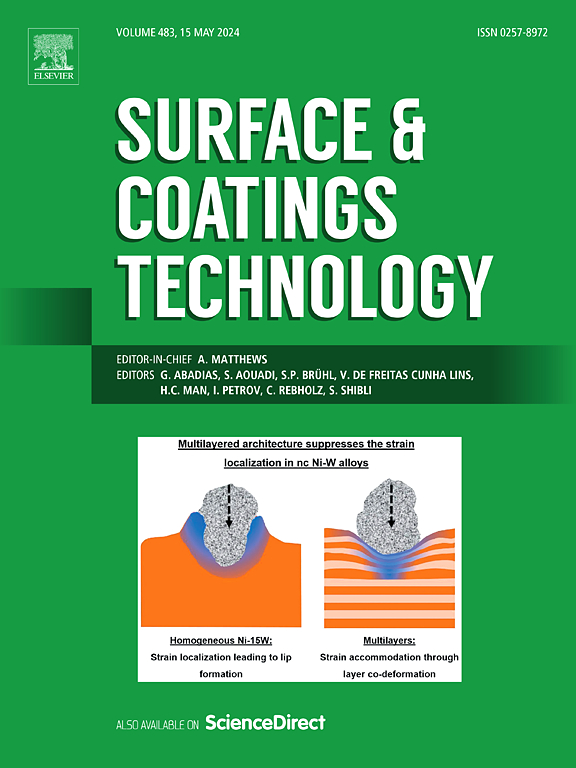表面功能分级材料在缓解闪络方面的适用性:从真空到压缩SF6气体
IF 5.3
2区 材料科学
Q1 MATERIALS SCIENCE, COATINGS & FILMS
引用次数: 0
摘要
表面功能分级材料(SFGM)在缓解高压设备固体绝缘闪络方面具有广阔的前景。本研究系统地探讨了 SFGM 的制造方法及其在各种情况下的适用性。制备了含有不同功能填料的涂层材料,以制造不同类型的 SFGM。闪变测试结果表明,分级介电常数涂层(ε-SFGM)和分级介电常数/电导率涂层(ε/ σ-SFGM)在工频压缩 SF6 气体中表现出优异的电强度增强效果。相比之下,SFGM 在真空中的改善效果有限。只有用碳化硅填料构建的ε/σ-SFGM 由于表面异质电荷的消散能力而在真空中显示出较好的闪络缓解效果。此外,还进行了数值模拟,以建立 SFGM 的构造方法与真空和压缩 SF6 气体中闪变阈值之间的关系,结果与实验结果一致。本文章由计算机程序翻译,如有差异,请以英文原文为准。
Applicability of surface functionally graded materials for flashover mitigation: from vacuum to compressed SF6 gas
Surface functionally graded materials (SFGMs) exhibit promising prospect in flashover mitigation of solid insulation in high-voltage apparatus. The construction methods and their applicability of SFGMs in various scenarios are systematically investigated in this work. Coating materials with different functional fillers were prepared to fabricated different types of SFGMs. Flashover testing results show that coating with graded permittivity (ε-SFGM) and coating with graded permittivity / conductivity (ε/ σ-SFGM) exhibit excellent electrical strength enhancement effect in compressed SF6 gas at power frequency. In contrast, the improvement effect of SFGMs are limited in vacuum. Only ε/ σ-SFGM constructed by SiC fillers shows a better flashover mitigation effect in vacuum due to the dissipation capability of surface hetero-charge. σ-SFGM constructed by carbon nanotube fillers would deteriorate surface electrical strength both in SF6 gas and in vacuum due to its excessive conductivity. Furthermore, numerical simulations were conducted to build the relationship between SFGMs construction methods and flashover threshold both in vacuum and compressed SF6 gas, which are in agreement with the experimental results.
求助全文
通过发布文献求助,成功后即可免费获取论文全文。
去求助
来源期刊

Surface & Coatings Technology
工程技术-材料科学:膜
CiteScore
10.00
自引率
11.10%
发文量
921
审稿时长
19 days
期刊介绍:
Surface and Coatings Technology is an international archival journal publishing scientific papers on significant developments in surface and interface engineering to modify and improve the surface properties of materials for protection in demanding contact conditions or aggressive environments, or for enhanced functional performance. Contributions range from original scientific articles concerned with fundamental and applied aspects of research or direct applications of metallic, inorganic, organic and composite coatings, to invited reviews of current technology in specific areas. Papers submitted to this journal are expected to be in line with the following aspects in processes, and properties/performance:
A. Processes: Physical and chemical vapour deposition techniques, thermal and plasma spraying, surface modification by directed energy techniques such as ion, electron and laser beams, thermo-chemical treatment, wet chemical and electrochemical processes such as plating, sol-gel coating, anodization, plasma electrolytic oxidation, etc., but excluding painting.
B. Properties/performance: friction performance, wear resistance (e.g., abrasion, erosion, fretting, etc), corrosion and oxidation resistance, thermal protection, diffusion resistance, hydrophilicity/hydrophobicity, and properties relevant to smart materials behaviour and enhanced multifunctional performance for environmental, energy and medical applications, but excluding device aspects.
 求助内容:
求助内容: 应助结果提醒方式:
应助结果提醒方式:


